How to Help Clients Training for a Trail Race (Free Guide)
Mastering the art of training clients for a trail race can significantly diversify your personal training services. But, it’s important that you have the right tools and knowledge to guide these clients effectively. Utilizing certain features of personal training software can prove invaluable in this task. Learn how to guide clients training for a trail race and all the best PT tools you’ll need in this comprehensive guide.
- Training clients for a trail race requires a balanced approach that integrates endurance workouts, strength and conditioning exercises, and balance and agility training for uneven terrain.
- Most trail race training clients will benefit from a systematic training plan that progressively increases their distance and hill running, while also incorporating cross-training to avoid overuse injuries.
- Incorporating workout and assessment software can assist in tracking progress, scheduling workouts, and managing recovery, ensuring your clients reach their trail race goals safely and effectively.
Guiding clients towards their trail race goals can provide personal trainers a fulfilling way to make a significant impact on their clients’ fitness journeys.
To help clients training for a trail race effectively, it’s crucial to not only understand the demands of trail running but also to have the right tools to monitor progress and adjust training plans; that’s where personal training software comes in. By leveraging the features offered by the best online personal training software, you can guide clients in their trail race training in a way that maximizes their performance and minimizes injury risk.
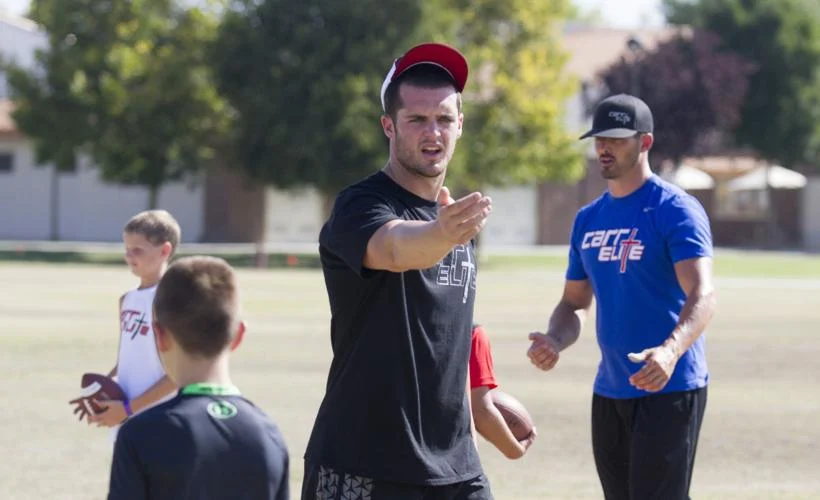
To get the best personal training software from Exercise.com, book a demo now!
Why Training for a Trail Race is Different
Trail running is a challenging and exhilarating sport that requires a unique approach to training. As a fitness professional, it’s important to understand the specific needs and goals of your clients who are training for a trail race. In this article, we will explore the various aspects of trail race training and provide you with comprehensive guidance on how to support and guide your clients towards success.
Training for a trail race differs from traditional road race training in several ways. First and foremost, the terrain is often unpredictable and uneven, requiring runners to develop balance and stability. Additionally, trail races often involve steep inclines and descents, which put different demands on the body compared to flat road surfaces. Finally, trail races may take place in remote or isolated locations, adding an element of self-reliance and wilderness skills to the training process.
Another key difference in training for a trail race is the need for mental preparedness. Unlike road races, trail races often require runners to navigate through challenging and unfamiliar terrain, which can be mentally taxing. Runners must be able to adapt quickly to changing conditions and make split-second decisions to avoid obstacles or choose the best path. This mental agility and resilience are crucial for success in trail racing.
Choosing the Right Trail Race for Your Client
Before diving into the training plan, it’s essential to help your client choose the right trail race. Factors to consider include the distance, elevation gain, technical difficulty, and location of the race. Encourage your clients to start with a race that aligns with their current fitness level and experience. Gradually progressing to more challenging races will allow for a safe and enjoyable training experience.
When selecting a trail race, it’s important to consider the terrain and weather conditions. Some races may take place in mountainous regions with steep climbs and rocky trails, while others may be held in flatter areas with smoother paths. Additionally, the weather can greatly impact the race experience, so it’s crucial to check the forecast and prepare accordingly.
Another factor to consider is the race atmosphere and organization. Some races may have a more competitive atmosphere with elite runners, while others may focus on a more relaxed and inclusive environment. Additionally, the organization of the race, including the availability of aid stations, course markings, and support staff, can greatly impact the overall experience for your client.
Read More:
- How to Help Clients Training for a Track Meet
- How to Help Clients Training for a Triathlon
- How to Help Clients Training for a 5K
- How to Help Clients Training for a Marathon
Assessing Your Client’s Fitness Level and Goals
Prior to designing a training plan, it is crucial to assess your client’s current fitness level and goals. Conduct a thorough fitness assessment, including cardiovascular endurance, muscular strength, and flexibility. This will help you tailor the training program to their specific needs and abilities. Additionally, discuss your client’s goals and motivations for participating in the trail race. Understanding their aspirations will enable you to provide appropriate guidance and support throughout the training journey.
During the fitness assessment, it is important to gather information about any previous injuries or medical conditions that may affect the client’s training. This will help you design a program that takes into account any limitations or precautions that need to be considered. It is also beneficial to assess their current lifestyle and daily activities to determine how active they are outside of their training sessions. This information will give you a better understanding of their overall fitness level and help you set realistic goals for their training program.
Designing a Customized Trail Race Training Plan
Once you have gathered all the necessary information about your client, it’s time to create a customized training plan. Consider incorporating various elements such as endurance runs, speed workouts, hill training, and recovery sessions. Gradually increase the volume and intensity of the workouts while allowing for adequate rest and recovery. A well-structured plan will help your client build the necessary endurance and strength to successfully complete their trail race.
When designing a customized trail race training plan, it’s important to take into account the specific terrain and conditions of the race. If the trail race includes steep inclines or technical sections, it may be beneficial to incorporate specific training exercises that mimic these challenges. This could include practicing uphill running, downhill running technique, and navigating through uneven terrain.
In addition to physical training, it’s also crucial to address mental preparation in the training plan. Trail races can be mentally demanding, requiring focus, resilience, and the ability to adapt to changing conditions. Consider incorporating mindfulness exercises, visualization techniques, and mental toughness training to help your client develop the mental fortitude needed to overcome obstacles and stay motivated throughout the race.
Incorporating Strength and Conditioning Exercises for Trail Running
Strength and conditioning exercises are crucial for trail runners as they help improve overall performance and reduce the risk of injury. Focus on exercises that target the lower body, such as squats, lunges, step-ups, and calf raises. Additionally, include exercises to strengthen the core, as a strong core helps with balance and stability on uneven terrain. Incorporating regular strength and conditioning sessions into the training plan will help your client develop the necessary strength and stability for successful trail running.
The Importance of Proper Nutrition for Trail Race Training
Nutrition plays a vital role in trail race training. Proper fueling and hydration strategies are essential for maintaining energy levels and optimizing performance. Encourage your client to consume a well-balanced diet that includes lean proteins, carbohydrates, and healthy fats. Additionally, emphasize the importance of staying hydrated throughout the training process. Provide guidance on pre-workout and post-workout nutrition to support muscle recovery and optimize training adaptations.
Essential Gear and Equipment for Trail Running
Trail running requires specialized gear and equipment to ensure comfort, safety, and optimal performance. Advise your clients to invest in a good pair of trail running shoes that provide sufficient grip and support. Additionally, recommend moisture-wicking clothing, a hydration system or water bottle, a headlamp for early morning or evening runs, a hat or visor for sun protection, and a small first aid kit. Ensuring your clients have the necessary gear will enhance their trail running experience while keeping them safe on the trails.
Injury Prevention Techniques for Trail Runners
Trail running can be physically demanding and puts strain on the body. As a fitness professional, it’s important to educate your clients on injury prevention techniques. Emphasize the importance of a proper warm-up and cool-down routine, as well as regular stretching and mobility exercises. Provide guidance on proper running form and technique, as well as strategies to prevent common trail running injuries such as ankle sprains and shin splints. By focusing on injury prevention, you can help your clients stay healthy and injury-free throughout their training.
Building Endurance and Stamina for Long-Distance Trail Races
Endurance and stamina are essential for completing long-distance trail races. To help your clients build their endurance, incorporate long runs into their training plan. Increase the distance gradually, allowing for sufficient recovery between long runs. Additionally, encourage your clients to vary their training terrain, incorporating hilly routes and technical trails to simulate race conditions. By gradually increasing both distance and difficulty, your clients will develop the endurance and stamina needed for their target race.
Hill Training Strategies to Improve Uphill Performance
Hill training is a crucial component of trail race preparation. Uphill sections are often challenging and can make or break a race performance. Incorporate hill repeats and sustained uphill runs into your clients’ training plan. Focus on proper form and technique, emphasizing the use of the arms and maintaining a consistent rhythm. As your clients become stronger and more efficient on the hills, their overall trail running performance will improve.
Downhill Running Techniques to Minimize Impact on Joints
Running downhill puts significant stress on the joints and muscles. Teach your clients proper downhill running techniques to minimize the impact and reduce the risk of injury. Encourage them to lean slightly forward, maintain a relaxed upper body, and take shorter, quicker strides. Emphasize the use of the glutes and quads to absorb the impact and maintain control. By mastering downhill running techniques, your clients will enhance their performance and reduce the risk of joint pain.
Cross-Training Activities to Enhance Trail Running Performance
Cross-training activities can greatly benefit trail runners by developing overall strength, coordination, and flexibility. Encourage your clients to incorporate activities such as cycling, swimming, yoga, and strength training into their training routine. These activities will help build a well-rounded athlete and reduce the risk of overuse injuries. Additionally, they provide mental and physical variety, keeping your clients engaged and motivated throughout their training.
Mental Preparation and Mindset for Trail Racing Success
Trail racing is not just a physical challenge; it’s also a mental one. Help your clients develop a strong mindset that will carry them through challenging moments during the race. Encourage them to practice mental techniques such as visualization, positive self-talk, and goal-setting. Teach them to embrace discomfort and overcome mental barriers. By cultivating a strong mental game, your clients will be better prepared to handle the ups and downs of trail racing.
Pre-Race Preparation Checklist for Your Clients
As the race day approaches, ensure your clients are well-prepared by providing them with a pre-race checklist. Advise them to familiarize themselves with the race course, pack all necessary gear and nutrition, and get a good night’s sleep before the race. Additionally, stress the importance of a proper warm-up and dynamic stretching routine on race day. By ticking off all the items on the pre-race checklist, your clients will feel confident and ready to take on their trail race.
Tips for Navigating Technical Terrain during a Trail Race
Technical terrain can pose a challenge for many trail runners, especially those new to the sport. Provide your clients with tips and techniques to navigate technical sections of the race course. Advise them to focus on their foot placement, maintain an upright posture, and look ahead to anticipate obstacles. Encourage them to practice on similar terrain during training sessions to build confidence and familiarity. By mastering technical terrain, your clients will feel more comfortable and in control during their trail race.
Hydration Strategies for Trail Runners in Various Conditions
Staying hydrated during a trail race is vital for performance and safety. Educate your clients on proper hydration strategies based on the race conditions. In hot and humid conditions, advise them to increase their fluid intake and consider using electrolyte supplements. In colder conditions, remind them that staying hydrated is just as important, even if they don’t feel as thirsty. Encourage your clients to practice their hydration strategy during training to ensure they have a plan in place for race day.
Managing Fatigue and Recovery during Intense Training Sessions
Intense training sessions can lead to fatigue and increased risk of injury. Teach your clients how to manage fatigue and prioritize recovery during their training. Emphasize the importance of rest days and active recovery sessions. Encourage them to listen to their bodies and adjust the training plan accordingly. Provide guidance on post-workout nutrition and the use of recovery techniques such as foam rolling and stretching. By managing fatigue and prioritizing recovery, your clients will reduce the risk of burnout and optimize their training adaptations.
Troubleshooting Common Challenges Faced by Trail Runners
Trail running presents unique challenges that your clients may encounter during their training. Address common challenges such as blisters, muscle cramps, and fueling issues. Provide practical tips and solutions to overcome these challenges. Encourage your clients to seek professional help if needed, such as visiting a podiatrist for foot issues or consulting a sports nutritionist for fueling strategies. By troubleshooting common challenges, you can ensure your clients stay on track and continue to progress in their trail race training.
Encouraging Reflection and Celebration of Milestones during Training
Throughout the training process, it’s important to encourage your clients to reflect on their progress and celebrate their milestones. Help them recognize the improvements they have made in their running ability, strength, and endurance. Celebrate reaching training milestones such as completing a long run or achieving a personal best in a specific workout. By acknowledging their achievements, your clients will stay motivated and inspired to continue their trail race training journey.
Trail race training requires careful planning, guidance, and support. By following the comprehensive strategies outlined in this article, you will be equipped to help your clients succeed in their trail race goals. Remember to tailor the training plan to their individual needs, provide ongoing motivation and support, and celebrate their achievements along the way. With your expertise and guidance, your clients will cross the finish line with confidence and pride.
How do you start training for trail running?
To start training for trail running, begin by gradually increasing your mileage and intensity. Start with shorter, easier trails and gradually progress to longer and more challenging routes. Focus on building endurance, strength, and agility through a combination of trail runs, hill repeats, and cross-training exercises. Gradually incorporate uphill and downhill running to prepare for the varied terrain of trail running. It’s important to listen to your body, practice proper trail etiquette, and invest in appropriate trail running shoes and gear.
How do you prepare for a trail run race?
To prepare for a trail run race, it’s essential to incorporate specific trail running workouts into your training. This includes running on trails that mimic the race conditions, practicing uphill and downhill running, and simulating race distance and elevation gain in your training runs. Gradually increase your training volume, focusing on endurance, strength, and speed. Additionally, practice fueling and hydration strategies during your long runs to ensure proper nutrition and energy during the race.
How do you train for a mountain trail race?
Training for a mountain trail race requires specific preparation due to the challenging terrain and elevation gain. Incorporate hill repeats, stair climbing, and uphill running to build strength and endurance. Train on trails that simulate the race conditions, including steep ascents and descents. Practice technical trail running skills, such as navigating rocks, roots, and uneven terrain. It’s important to gradually increase your training volume and elevation gain to adapt to the demands of the race.
How do you train for your first trail race?
To train for your first trail race, start by gradually increasing your mileage and running duration on trails. Focus on building endurance through long, slow runs. Incorporate hill workouts and intervals to improve strength and speed. Practice running on varied terrain to develop agility and stability. It’s important to listen to your body, allow for proper rest and recovery, and gradually build up your training volume and intensity. Consider seeking guidance from experienced trail runners or a coach to help tailor your training plan.
What exercises improve trail running?
Several exercises can help improve trail running performance. Strengthening exercises for the legs and core, such as squats, lunges, step-ups, and planks, can improve stability, power, and endurance. Plyometric exercises like box jumps and jump lunges can enhance explosive power. Incorporating balance and proprioception exercises, such as single-leg balances or Bosu ball exercises, can improve stability and coordination on uneven terrain. Additionally, practicing downhill running technique and incorporating agility drills can improve speed and agility on trails.
What are the strength exercises for trail running?
Strength exercises for trail running focus on building lower body strength, core stability, and overall muscular endurance. Examples include squats, lunges, step-ups, calf raises, hip bridges, planks, Russian twists, and mountain climbers. Incorporating resistance training with weights, resistance bands, or bodyweight exercises can help improve power and strength. It’s important to include exercises that target the specific muscles used in trail running, such as the glutes, quadriceps, hamstrings, calves, and core muscles.
How do you train for endurance trail running?
To train for endurance trail running, gradually increase your weekly mileage and long run duration. Focus on building a strong aerobic base through steady-state runs and long, slow distance runs. Incorporate interval training, hill repeats, and tempo runs to improve speed and endurance. It’s important to practice proper nutrition and hydration strategies during your long runs to support sustained energy levels. Gradually increase the duration and difficulty of your training runs to build the endurance needed for trail races.
How do you train for a 50-mile trail race?
Training for a 50-mile trail race requires a structured and progressive training plan. It’s important to build a strong endurance base by gradually increasing your weekly mileage and long run distance over several months. Incorporate back-to-back long runs on consecutive days to simulate race conditions. Practice running on varied terrain, including technical trails and elevation changes, to prepare for the race course. Train on similar terrain and elevation gain as the race to familiarize yourself with the demands of the event. Additionally, incorporate strength training, cross-training, and recovery strategies to support your training and minimize the risk of injury.
How do you train for a trail run with elevation?
To train for a trail run with elevation, incorporate hill repeats and uphill running into your training regimen. Find trails or routes with significant elevation gain to simulate race conditions. Practice power hiking and maintaining a steady effort level on uphill sections. Train on descents to improve downhill running technique and build strength in the quadriceps and stabilizing muscles. Gradually increase the elevation gain and difficulty of your training runs to adapt to the demands of the race. Focus on building both strength and endurance to tackle the challenging terrain with elevation.
Can you train for a trail run on a treadmill?
While it’s ideal to train for a trail run on actual trails to simulate race conditions, training on a treadmill can still be beneficial, especially if you don’t have access to trails or are preparing for a specific race with unique challenges. To make treadmill training more trail-specific, adjust the incline settings to mimic uphill and downhill sections. Incorporate intervals of varying speeds and inclines to simulate the varied terrain of a trail. Additionally, supplement your treadmill training with strength and balance exercises to enhance stability and prepare for technical sections. However, whenever possible, try to incorporate outdoor trail runs into your training to fully prepare for the race.
How do you train to run with no experience?
If you have no running experience, it’s important to start slowly and gradually build up your endurance and mileage. Begin with a combination of walking and running intervals, gradually increasing the amount of time spent running and reducing walking breaks. Follow a beginner’s running plan, such as the Couch to 5K program, that provides a structured approach to gradually increase running duration and intensity. Focus on maintaining good form, wearing proper running shoes, and listening to your body to avoid injury. Consistency and patience are key, allowing your body time to adapt and progress at a pace that suits your fitness level.
How do you lift and train for track?
Strength training can be beneficial for track athletes to improve power, speed, and overall performance. Focus on compound exercises that target major muscle groups, such as squats, deadlifts, lunges, and bench presses. Incorporate plyometric exercises, such as box jumps, jump squats, and medicine ball throws, to enhance explosive power. Additionally, include exercises that target specific muscle groups used in track events, such as calf raises for sprinters or shoulder exercises for throwers. It’s important to work with a qualified strength and conditioning coach or trainer to develop a program that aligns with your specific track goals and individual needs.
How do you prepare for a track team?
Preparing for a track team involves a combination of endurance training, speed work, and specific event-focused training. Start by building a strong aerobic base through regular running and cardiovascular exercises. Gradually incorporate interval training, such as track workouts or fartlek runs, to improve speed and stamina. Focus on event-specific drills and practice to develop technique and efficiency. Joining a track team provides access to professional coaching, structured training programs, and the opportunity to train alongside other athletes. Communicate with your coach, follow the team’s training plan, and stay committed to consistent training to prepare for track competitions effectively.
Use the Best Personal Training Software to Offer a Stellar Client Experience
Training clients for trail running requires a comprehensive and tailored approach. See how Exercise.com can help.

To learn more about how Exercise.com can help you run your fitness business, book a demo now!
Creating Training Plans for Clients Who Want to Compete in Trail Running
Here’s how you can help your clients accomplish their goals by using workout plan creator software to create workout plans, run fitness challenges, offer online workout groups, message clients, and more, all from your very own custom branded fitness apps.
Exercise.com stands out as an all-in-one fitness business management software with comprehensive workout plan sales capabilities. The robust member management, billing & invoicing, and unique fitness assessment tools offer a one-stop solution for fitness business needs. Here’s just some of what you can do with the Exercise.com platform:
Engage with clients via automations.
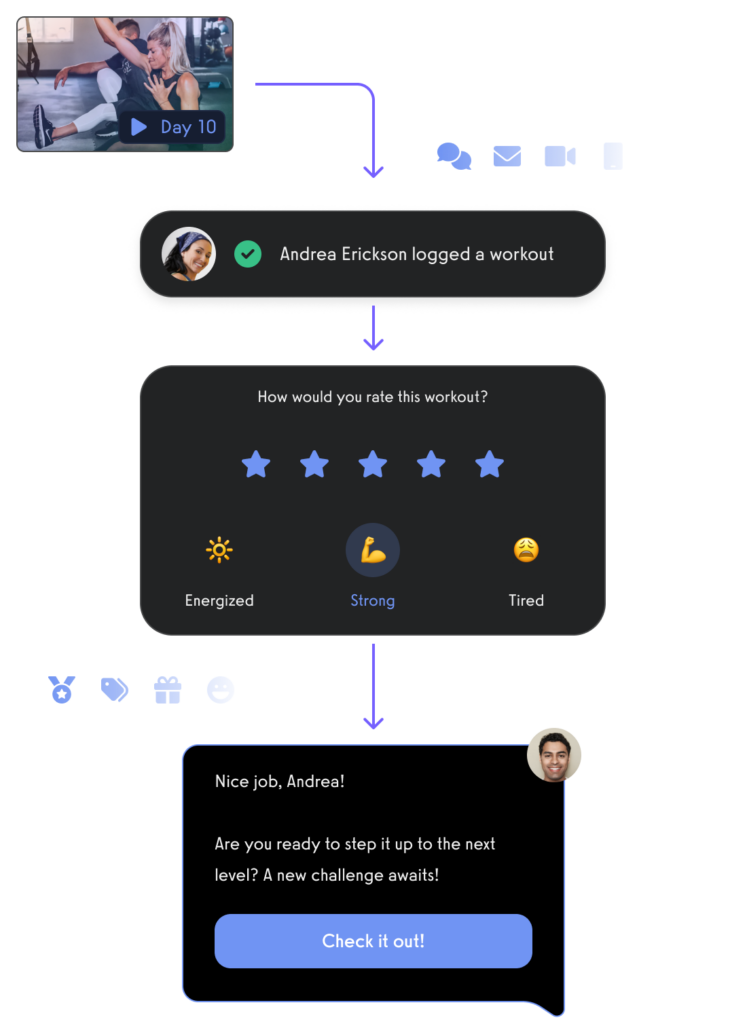
Manage leads with a fitness CRM. Read More: Find the Best Gym CRM Software

Create and send fitness assessments with ease.
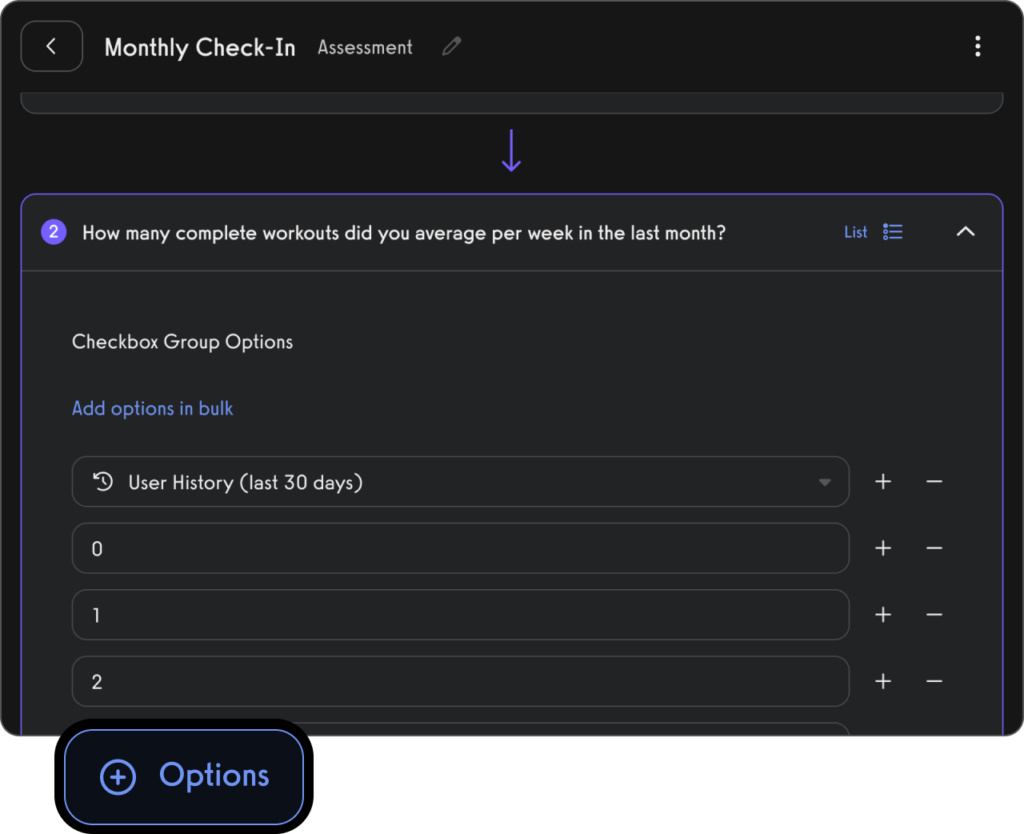
Use fitness habit tracking to inspire and motivate personal training clients (in-person and remote).

Use fitness progress photos to engage with clients.
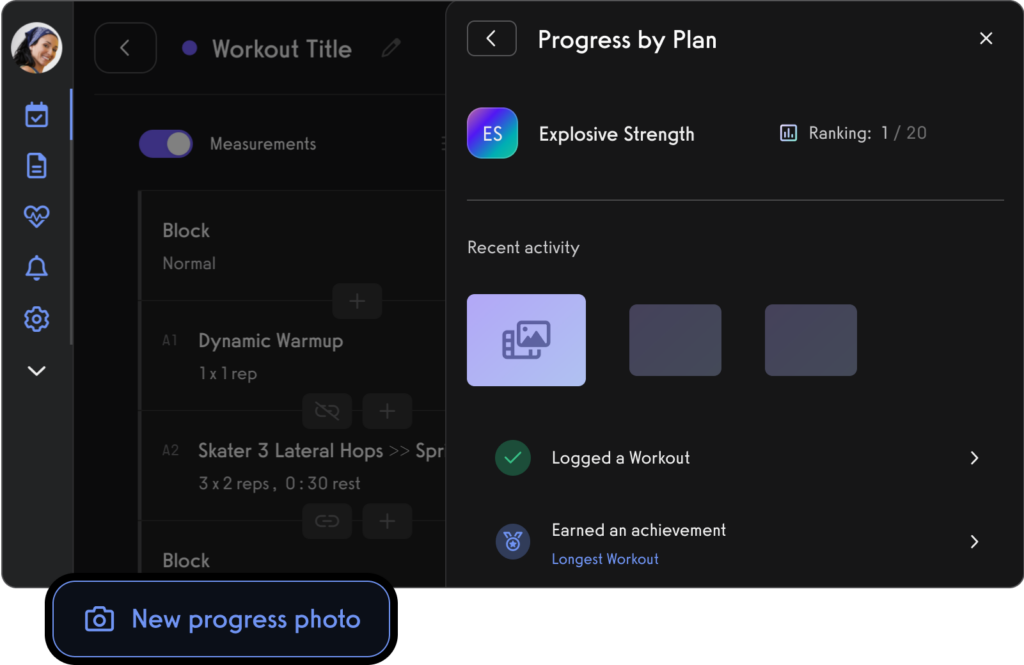
Use fitness leaderboards to track performance and inspire healthy competition.
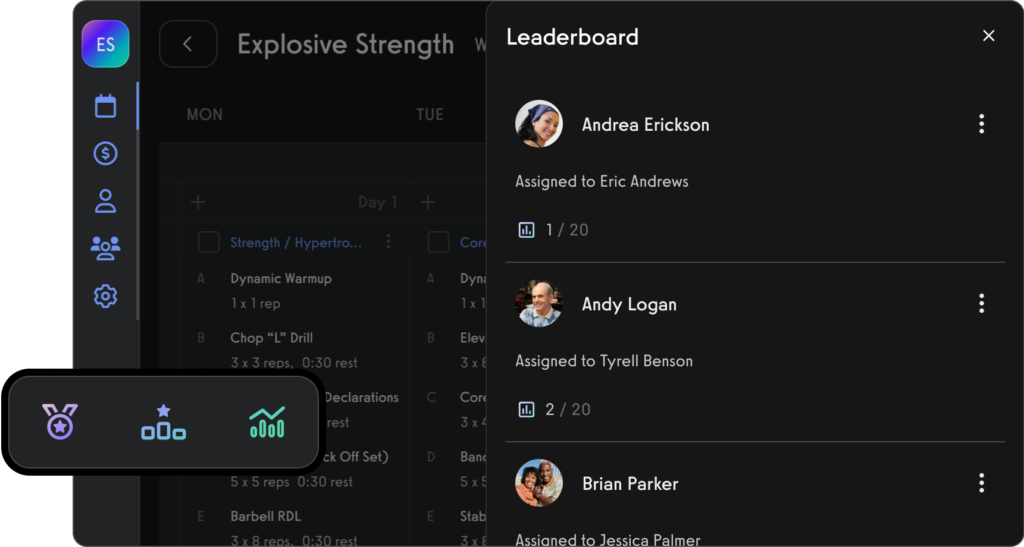
Use the exercise demonstration video library or create your own custom exercise demonstration videos.
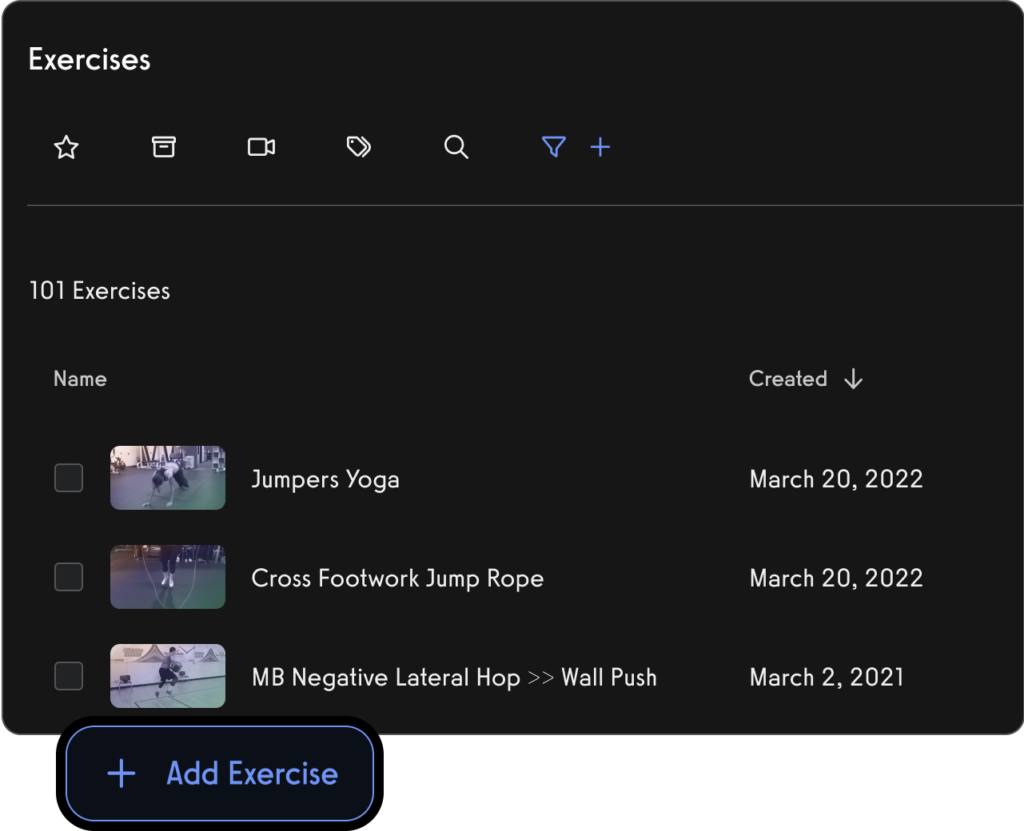
Create workout plans for parents and dependents, teams and more.

Manage personal training clients with ease.
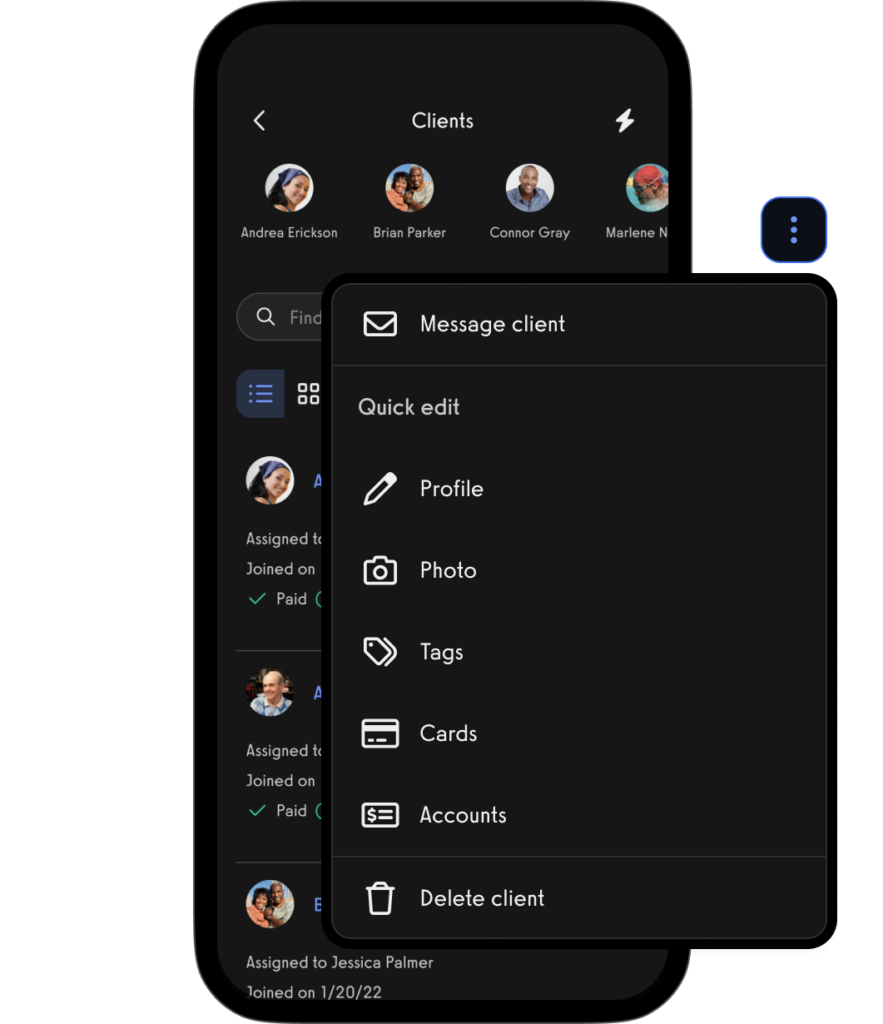
Book appointments for clients (Read More: Best Gym Booking Software)

Create classes and fitness groups

Manage fitness challenges (Read More: 100+ Fitness Challenge Ideas)
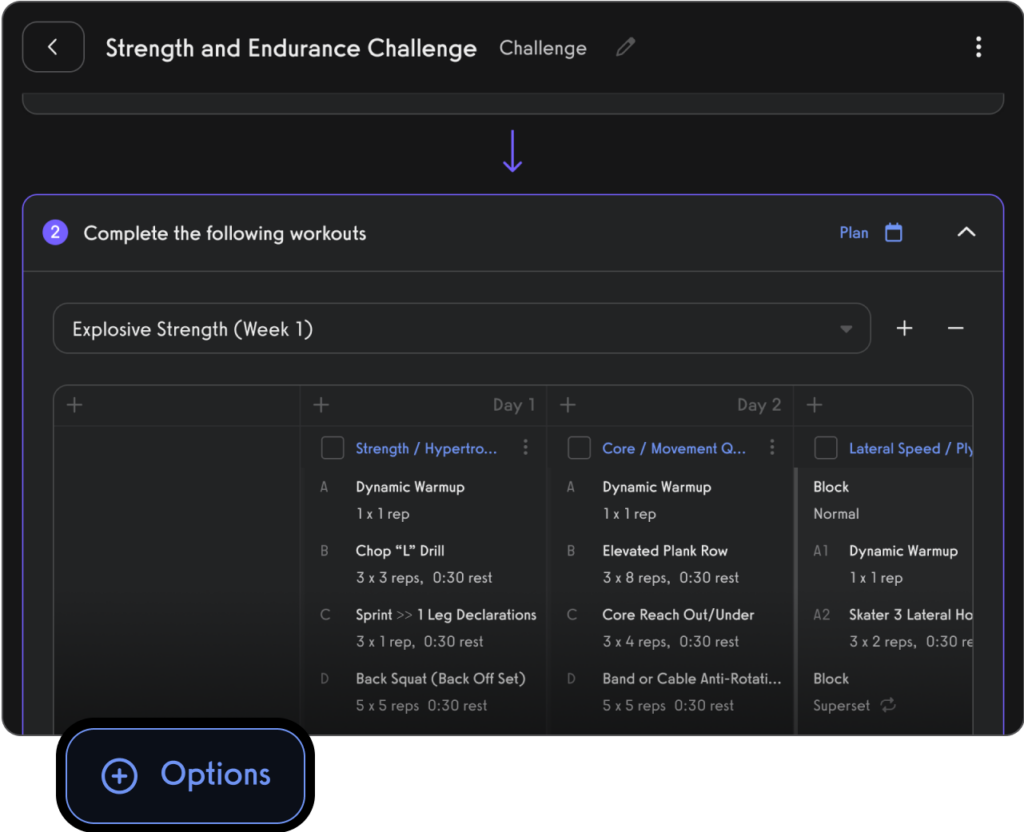
Process payments for open gym, classes, and personal training.

Communicate with gym members, athletes, team members, personal training clients, class members, parents, and dependents via SMS, email, and in-app push notification.
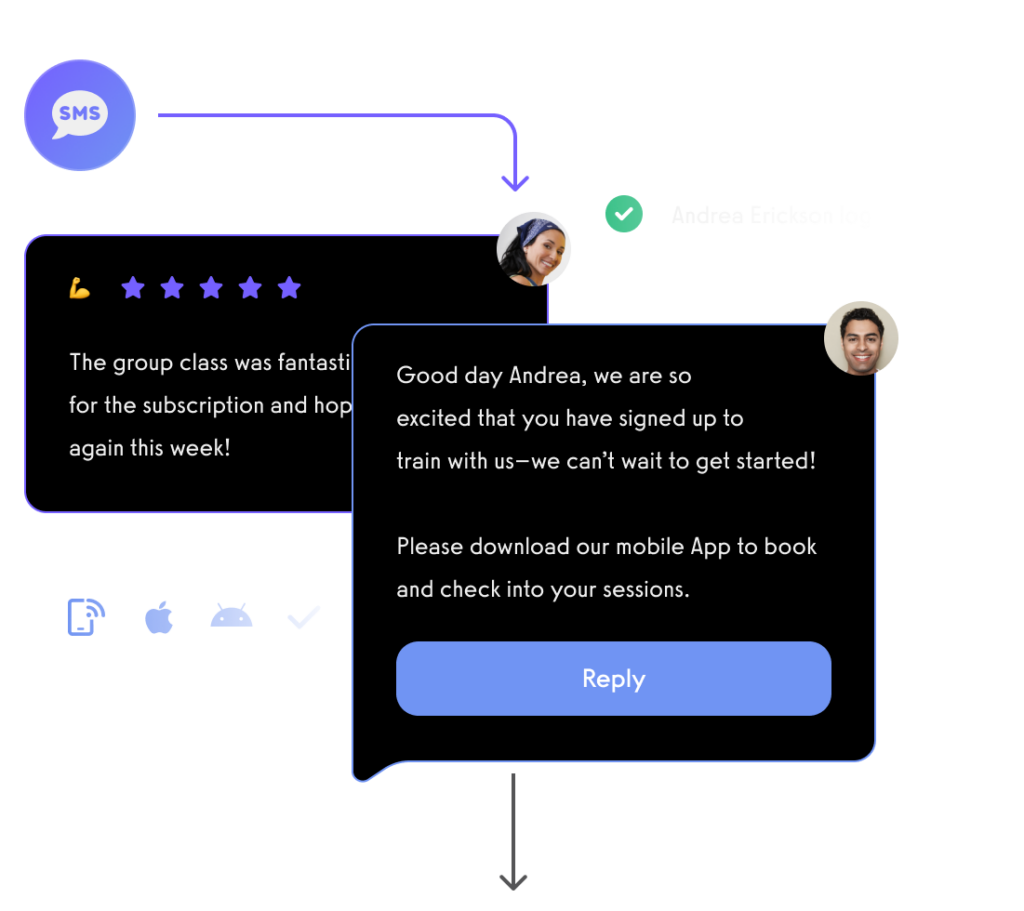
View performance over time, track personal records, and other fitness stats with performance reporting dashboards.

And of course, view all of your fitness business reports easily too.

All from your custom-branded fitness apps (Read More: Best Gym Mobile Fitness Apps Software)

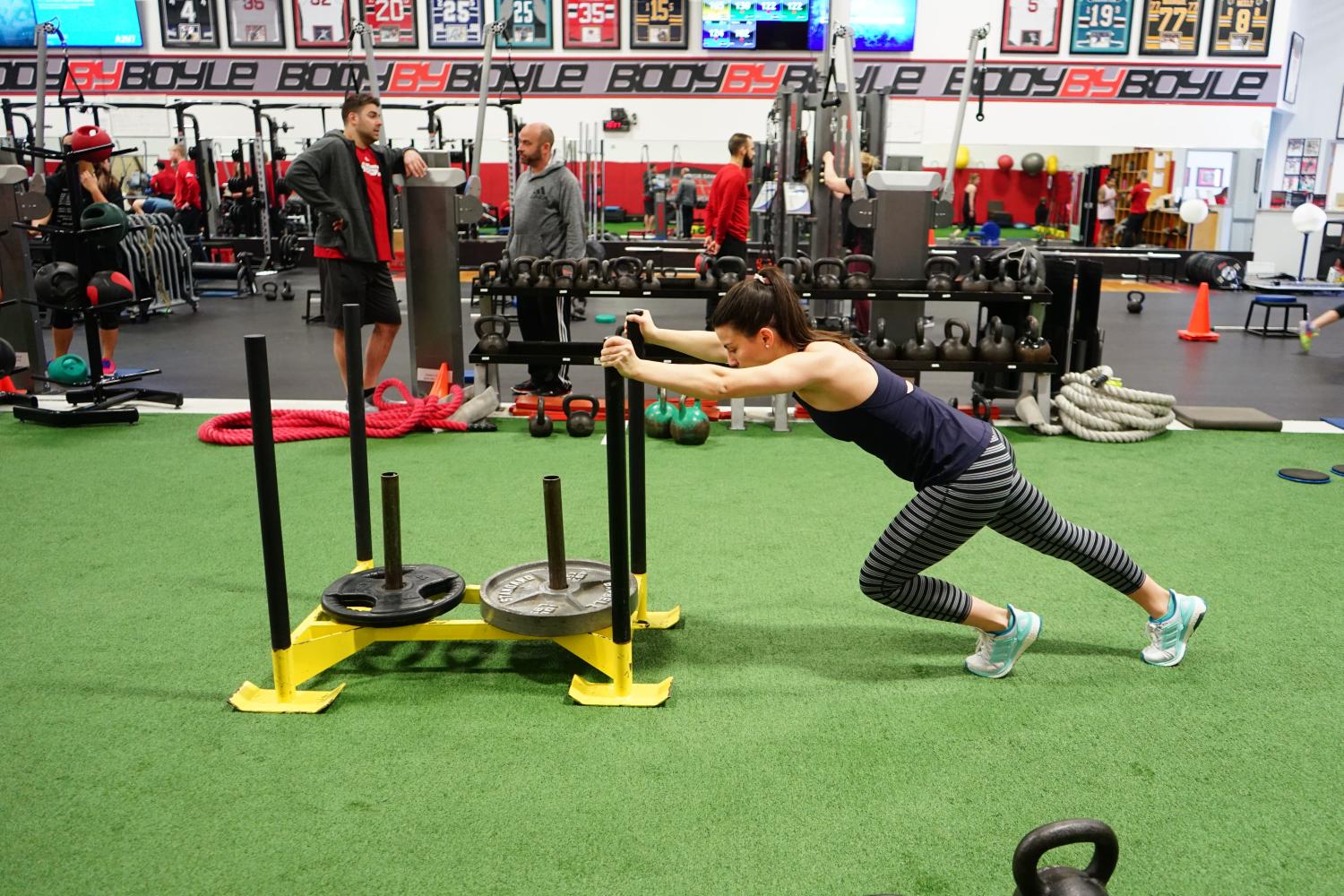
Want to learn how your fitness business can take it to the next level? Get a demo now!









